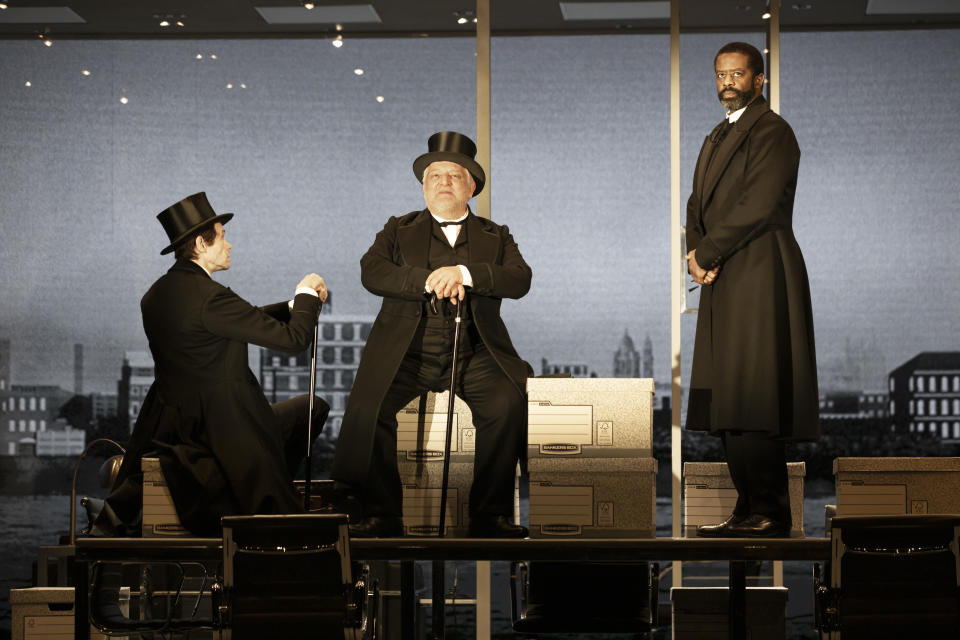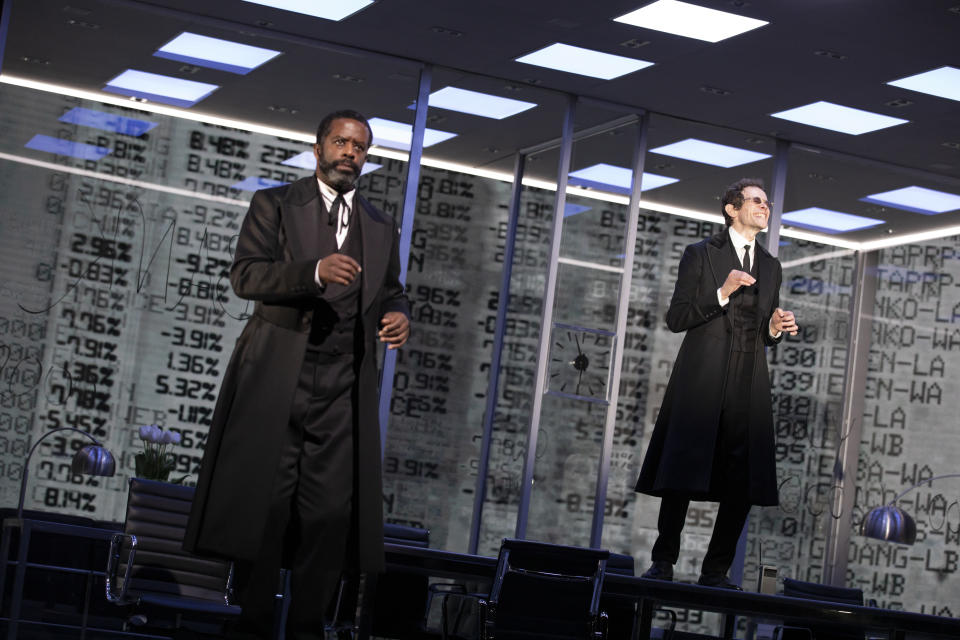‘The Lehman Trilogy’ Broadway Review: An Empire Rises, Falls And Inspires A Masterpiece
- Oops!Something went wrong.Please try again later.
- Oops!Something went wrong.Please try again later.
- Oops!Something went wrong.Please try again later.

Money, the pop song says, changes everything, and as Broadway’s magnificent The Lehman Trilogy so splendidly demonstrates, everything means everything, from the most private of personal circumstances to – if you’ve got enough cash (or even the suggestion of it) – the grand sweep of history.
And did the Lehmans ever have enough cash (complete that statement with an exclamation mark or a question mark, and it works either way). Brothers Henry, Mayer and Emmanuel Lehman – names Americanized from the original German by U.S. immigration gatekeepers – arrive on these shores a decade before the Civil War with nothing that couldn’t fit in a suitcase. Their fortunes would help build a country, finance its achievements, fund its greatest sins and bring the globe to near collapse more than once.
More from Deadline
Directed with astonishing grace and ingenuity by Sam Mendes, the Stefano Masinni play, adapted by Ben Power and based on Masinni’s novel, is maybe the single most effective display of imaginative theatrical storytelling since Angels in America landed on Broadway in 1993, a comparison brought to mind by their shared ambition, breadth of style and substance, and deep delight in the inventiveness that transforms everything on stage into a spellbinding demonstration of theater’s possibilities.
To start at the beginning: The National Theatre production opening tonight at the Nederlander Theatre opens with the arrival onstage of a solitary figure – Henry Lehman, played by Simon Russell Beale, but more about the cast shortly – dressed in the familiar black garb of the 19th Century Jewish immigrant. Actually, Henry is the second person on stage – in a very brief prologue, a janitor in 2008 sweeps away the office rubbish that will be left in the wake of everything we’re about to witness, everything that begins with the arrival on Ellis Island of Henry Lehman.

Julieta Cervantes
In a description that will oversimplify to an absurd degree, the set is a transparent cube, a glasslike square that will serve as everything from a humble Alabama country store to the cloud-touching offices of a Wall Street giant. Cardboard file boxes will be shuffled, stacked, knocked over and restacked to create any number of structures and settings, and video projections (designed by Luke Halls) place the action among cotton fields and skyscrapers, land and water, through the ages of slavery, wars, crashes and computers.
Henry arrives at Ellis Island alone, 10 pounds lighter than when he began his 45-day sea voyage and already wiser in the ways of the world and steerage than could ever have been gained in the Bavarian village of Rimpar, Germany. Within three years he’s opened a tiny dry goods shop in, of all place, Montgomery, Alabama, catering to the poor, the overseers, anyone in need of clothes sturdy, durable and cheap.
In short order, Henry is joined by younger siblings Emmanuel (Adrian Lester) – the “arm” to Henry’s “head” – and Mayer (Adam Godley), the baby brother derisively nicknamed Spud because his face is as smooth as a peeled potato. Mayer, even he acknowledges, serves mostly to separate the other two: “So the arm doesn’t crush the head and the head doesn’t humiliate the arm. That is why he was sent to America…”
Mayer’s middle-man position will take on unexpected value and importance and lay a sort of symbolic groundwork for the role this fledgling business will play in the establishment of a 20th Century economy: this little mercantile will all but invent the industry that will come to be known as investment banking. They will become, in short, the middle-men, the go-between between the makers and the sellers of goods.
How the brothers (and their offspring) accomplish that feat is told in three and a half fast-moving hours, moving from the blood-soaked years of the Old South, when the Lehmans transitioned from selling cotton clothes to selling the cotton itself, through their fortune-making days as brokers of Reconstruction, and on through the giddy stock market era of the early 20th Century, its crash in 1929, the profits of World War II and on through the transformation of selling as a practice into selling as concept, when marketing executives showed first the Lehman family and then the world that the most lucrative thing to sell is the very idea of selling. Or rather, the idea of buying, which the Lehmans and their peers will convince the world is one and the same as the idea of living.
Sounds weighty, right? But the miracle of The Lehman Trilogy is not just in its scope, but in the dizzying, forward momentum of its story-telling. The three actors play not only the original brothers, but the multitudes – family and otherwise – who would follow over the decades. In an ingenious move that allows for both the arc of history and the revelations of the most private of thoughts, the story is largely recounted in the third person, so we hear Henry introduce himself like this:
“He had been dreaming of America. The son of a cattle merchant, a circumcised Jew, with only one piece of luggage, stood as still as a telegraph pole, on Dock No. 4 in the port of New York. Thank God he’d arrived. Baruch HaShem! Thank God he’d left. Baruch HaShem! Thank God he is now, finally in America. Baruch HaShem!”
And here is how we are told of the start of the Civil War, as first Mayer observes it in Alabama and then Emanuel in Manhattan:
Mayer: “The first cannon shot of the Civil War wakes Mayer Lehman in Montgomery. His first thoughts are for his storerooms of cotton. He throws open the window: Montgomery has gone wild. Crowds on the street celebrating: The Cotton States claim independence!”
Then Emanuel: “The first cannon shot of the Civil War wakes Emanuel Lehman in New York. His first thoughts are for his buyers! He goes to the window: New York has gone wild. People in the street celebrating: End slavery now: constitution and rights!“
And many decades later, here is how we meet a non-Lehman character, a stockbroker named Teddy whom we encounter, briefly, for the first and last time on Oct. 24, 1929:
“What if everyone, instead of wanting other stock, just wants their money back? What if everyone stops believing?! What am I going to do? Teddy locks himself in the bathroom. A bullet. A trigger. A shot.”
And so it goes, one fascinating character, one indelible performance after another, each one laying claim to the play’s most unforgettable until the next comes along. First among the equals: Robert “Bobby” Lehman, the saga’s Prince Hal who begins his history as a free-thinking, art-loving Yalie, rises to the challenge of the Depression and ultimately lays the groundwork for disaster when he becomes enamored of the selling-nothing concept in the 1960s.

Julieta Cervantes
Bobby, like Mayer, is played by Godley – the actors remain costumed in their 19th Century garb, as if transporting ghosts and legacies from one epoch to the next – and the character and actor are responsible for one of the evening’s most thrilling moments, when the aging Bobby, the last of the original brothers and desperate to stay young, dances the Twist as he describes the 1960s. He Twists and Twists as his body becomes decrepit, his voice a demonic croak. “He dances like a madman,” Godley-as-Bobby says without breaking stride. “He dances so hard that he doesn’t notice when the ground comes up to meet him. He doesn’t notice that the music has stopped. He doesn’t notice that the last Lehman died dancing the Twist.”
Highlighting that one scene seems unfair, though, since The Lehman Trilogy is a never-ending stream of such dazzlers, and every one of them is performed without flaw by the remarkable cast of actors, all but one – Lester – imported from the acclaimed original London production. Each actor builds his population of characters with a precision that makes every Lehman (and every non-Lehman who enters the Lehman world) a fully etched, self-contained bundle of ambitions and fears and loyalties and greed. This is acting as magic.
The cast is assisted – though assisted is too weak a word, so better to say equaled – by a team of master stage workers at the tops of their games, from Mendes, for whom Lehman marks an artistic peak, to sound designer and composer Nick Powell, who has written the gorgeous piano score (played, expertly, by pianist Candida Caldicot seated silent film-style between the audience and the stage). Jon Clark’s lighting design, Katrina Lindsay’s costumes (keep an eye on those long black coats as they prove wittily versatile over decades and genders) and Es Devlin’s instantly iconic spinning cube set.
And a second mention is merited for video designer Halls, whose projections shoulder the logistics of time and place while simultaneously providing an artistic statement that one could easily imagine forming its own exhibit at the Museum of Modern Art. Thrilling is the word, as we see eerie visions of a Statue of Liberty adrift and lonely in New York Harbor, or a nightmarishly fast ascent up, up, up the looming skyscrapers that haunt the sleepless nights of one particularly terrified Lehman.
That terror, we know from the beginning, is well founded. At some point all those cardboard boxes and monumental buildings and glass offices are going to come crashing down, figuratively, literally and finally. Even the most schooled experts of financial history will be left dumbstruck by just how, exactly, the fall of Lehman is brought to life, how the nothing that Henry Lehman brought to America returns to claim the something that he and his brothers willed into existence. Like those 19th Century immigrants, Mendes, Massini, Power and their team of artists have conjured a world through sheer imagination and know-how, stacking the pieces box by box, layer by layer, into a something magical. We can’t look away, dazzled by the sorcery.
Best of Deadline
Sign up for Deadline's Newsletter. For the latest news, follow us on Facebook, Twitter, and Instagram.

